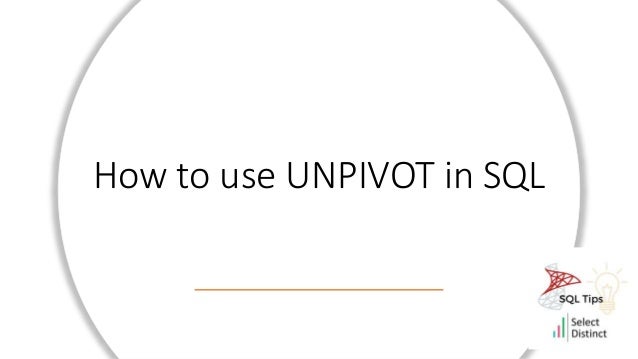
SQL Tips UNPIVOT Function.pptx
- 1. How to use UNPIVOT in SQL
- 2. The UNPIVOT function in SQL is used to turn a dataset from columns to rows
- 3. From This… A wide table of columns Such as this…. To this….. A table of Year, Month and days per month
- 4. Data Set Up If you want to follow this example, you can run the following SQL to create the dataset used in this example CREATE TABLE [dbo].[UNPIVOT_Example]( [year] [int] NULL, [January] [int] NULL, [February] [int] NULL, [March] [int] NULL, [April] [int] NULL, [May] [int] NULL, [June] [int] NULL, [July] [int] NULL, [August] [int] NULL, [September] [int] NULL, [October] [int] NULL, [November] [int] NULL, [December] [int] NULL ) ON [PRIMARY] GO INSERT [dbo].[UNPIVOT_Example] ([year], [January], [February], [March], [April], [May], [June], [July], [August], [September], [October], [November], [December]) VALUES (2018, 31, 28, 31, 30, 31, 30, 31, 31, 30, 31, 30, 31), (2019, 31, 28, 31, 30, 31, 30, 31, 31, 30, 31, 30, 31), (2020, 31, 29, 31, 30, 31, 30, 31, 31, 30, 31, 30, 31), (2021, 31, 28, 31, 30, 31, 30, 31, 31, 30, 31, 30, 31), (2022, 31, 28, 31, 30, 31, 30, 31, 31, 30, 31, 30, 31) GO
- 5. select Year, Month, days from [dbo].[UNPIVOT_Example] UNPIVOT (days for Month in ([January] , [February] , [March] , [April] , [May] , [June] , [July] , [August] , [September] , [October] , [November] , [December]) )as dpm_unpivot SQL UNPIVOT Here is the SQL code and a breakdown of what each part does 3. This is the final set of columns that we want to output 2. This is the start of the UNPIVOT function, We define the column ‘MONTH’ using the full list of existing column names ‘days’ is the new name for the column of data that we will generate from the UNPIVOT 1. Here we select each of the columns of data that we want to be unpivoted
- 6. Use Cases SQL UNPIVOT is very useful when the data you have to work with is already in a PIVOTED style Quite often we come across that is provided to us in this way, usually as outputs from proprietary systems Converting these to tabular data sets makes working with the data much easier, and allows far simpler work if you need to aggregate all the data by year
- 7. Hope you found this useful
- 8. For more Tips, Tricks and Timesavers, visit our website Tips and Timesavers | Select Distinct Limited Credit: Simon.harrison@select distinct limited
